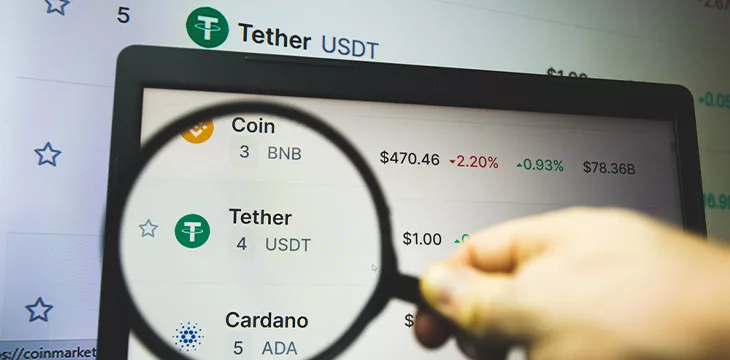|
Getting your Trinity Audio player ready...
|
Tether is fueling stablecoin-based criminality across Southeast Asia, while Circle is furiously trying to promote its USDC stable as a crime-free alternative before taking another shot at an initial public offering.
The United Nations Office on Drugs and Crime (UNODC) issued a new report detailing how Tether’s USDT stablecoin is rewriting the role of underground banking in Southeast Asia’s transnational organized crime networks. The report notes how “illegal and underregulated cryptocurrency exchanges have become foundational pieces of the banking architecture used by organized crime.”
The report details the massive underground banking networks that support both Macau’s casino ‘junket’ operators, who assist gamblers in evading China’s strict capital controls, as well as illegal China-facing online gambling sites. Following China’s Operation Chain Break targeting third- and fourth-party payment processors, authorities observed significant growth in the use of “sophisticated, high-speed money laundering ‘motorcade’ teams specializing in underground USDT [to] fiat currency exchanges (卡接回U) across East and Southeast Asia.”
These ‘motorcades’ are promoted on “major platforms where criminals advertise ‘services’ for one another, including Facebook, TikTok, and Telegram groups.” The system involves “sophisticated layering schemes by routing money through multiple bank or cryptocurrency exchange accounts for a percentage of the total laundered and transferred funds.” Those at the ‘front of the car’ who take the most risk can earn 20-40% commission fees.
Further down the money laundering chain, illegal online gambling platforms are “among the most popular vehicles for cryptocurrency-based money launderers, particularly for those using Tether or USDT on the TRON blockchain, while also fueling the intensification of Southeast Asia’s rapidly growing illicit digital economy, and particularly the regional cyberfraud industry.”
A recent ChainArgos report supports this last point, arguing that “scamming and the laundering of scam proceeds was not just a use case for cryptocurrencies in Asia, but […] may well even be, empirically, crypto’s killer app.” ChainArgos added, “the main token used in such scamming, by far, is USDT.”
The UNODC report notes that cyber fraud operators are often engaged in human trafficking, with the UN Human Rights Office estimating there are “more than 220,000 people being held in situations where they are forced to carry out various cyberfraud and scam activities in Cambodia and Myanmar alone.”
The UNODC report adds that while blockchain analytics firms claim that less than 1% of digital asset payments are illicit, the Association of Certified Anti-Money Laundering Specialists (ACAMS) reported last year that the volume attributed to organized crime is vastly underestimated. For one thing, the report notes the prevalence of ‘wash trading’ on exchanges that artificially inflates transaction volume and thus shrinks the portion of identifiably illicit transactions.
While USDT remains the primary method by which criminal gangs (and terrorists) move their cash around, the report also cites the importance of less prominent tokens that often undergo sudden bouts of exponential growth, making it “easy to justify unexpected wealth.”
Tether CEO/CTO/fall guy Paolo Ardoino responded to Spanish media coverage of the UNODC report by calling it “Classic poor research.” As always, just like Binance’s fallen founder Changpeng ‘CZ’ Zhao used to do before U.S. authorities clipped his wings, Ardoino failed to specify exactly what aspects of the UNODC report he found wanting.
Tether later issued an official ‘challenge’ to the UN report, which took issue with the UN ‘singling out USDT’ while ignoring all the (alleged) benefits that the world’s leading crime coin has to offer. Tether said the UN “could benefit from an expanded understanding of blockchain technology” and invited the UN to “engage in collaborative dialogue.” We imagine Ardoino’s role in this dialogue would be akin to Monty Python’s Argument sketch, simply saying “no, it isn’t” to every damning UN allegation.
Once more unto the IPO breach
Negative publicity aside, 2023 was a banner year for Tether, as its share of the overall stablecoin market increased from 50% to 71%. That growth came primarily at the expense of (a) Circle’s USDC, which many USDT holders use as exit liquidity (due to Tether’s tenuous ties to U.S. banking), and (b) the demise of the Binance/Paxos project BUSD, which evaporated following a public spanking by New York regulators.
Tether’s current market cap is just under $95 billion, a record high and nearly $30 billion more than at the start of 2023. USDC’s cap currently stands at $25.4 billion, down from nearly $44 billion one year ago. BUSD suffered an even greater plunge, falling from over $16 billion to its current cap of just $520 million.
In addition to involuntarily serving as a means for USDT holders to cash out to fiat, USDC suffered a PR black eye last spring when the collapse of Silicon Valley Bank threatened to eviscerate $3.3 billion in USDC reserves. A U.S. government bailout ultimately pulled USDC’s butt out of the fire, but confidence in Circle’s management was badly shaken.
Making this a curious time for Circle to announce that it had confidentially filed a draft registration statement with the U.S. Securities and Exchange Commission (SEC) for an initial public offering (IPO). The two-paragraph announcement offered few details on Circle’s plans, citing the number of shares to be offered and the price of those shares as TBD, while Circle CEO Jeremy Allaire’s X/Twitter account pretended the announcement never happened.
Circle previously planned to go public via a special purpose acquisition company (SPAC) vehicle, Concord Acquisition Corp, but the merger fell apart the following year as the broader digital currency market suffered a string of embarrassing failures, frauds, and other hijinks that took the shine off the proposal.
In 2021, token prices were touching record highs, and the future seemed blindingly bright. While token prices are once again on the march, Circle’s future seems far less rosy, given its reduced market cap and questions regarding the soundness of its business practices.
Worse, Circle’s revenue generation is now overly reliant on the U.S. Federal Reserve, keeping interest prices high and allowing Circle to reap big rewards on the T-bills representing USDC’s reserves. But the Fed is expected to start chipping away at those high rates, with some analysts expecting as many as five cuts this year beginning in March.
Circle’s announcement came the day after the SEC approved 11 BTC spot-based exchange-traded funds (ETF), which failed to set the world on fire in their first two days of trading. Circle may be hoping that some of that hopium might be transferred to its IPO plans. Circle may also be hoping against hope that a dysfunctional Congress can actually pass stablecoin-friendly legislation.
Either that or Circle is praying that U.S. authorities will finally announce some kind of legal crackdown on its larger rival, Tether.
Four out of five dentists recommend USDC
Circle has already begun salting the mine for IPO success with the release of a new State of the USDC Economy report. This lengthy tome is dedicated to all the wonderful ways in which Circle is making the world a better place, from upgrading the financial system to solving the heartbreak of psoriasis. (Probably more of the former, less of the latter.)
Among the informative tidbits that Circle wants the world to know is the number of on-chain digital wallets holding “at least $10 in USDC,” rising by 59% to 2.7 million in 2023. Unfortunately, the rest of the report’s stats are a lot fuzzier, often comparing USDC’s share of particular aspects of digital asset trading/transfers to those made with fiat currencies, often with a heavy ‘apples to oranges’ vibe.
There are also many generic projections for, say, how many people in certain global regions will be using digital wallets by 2025, but tracing these claims back through the footnotes reveals that the projections were made three or four years ago. Then there are the impressive stats detailing international remittance volume, and how USDC is an option with many leading companies handling remittances, but no hard numbers on how often USDC is the option chosen by these companies’ customers.
Circle’s failed 2022 IPO valued the company at $9 billion. If it wants to attain anywhere near that valuation this time around, it’s going to have to do better than this.
Follow CoinGeek’s Crypto Crime Cartel series, which delves into the stream of groups—from BitMEX to Binance, Bitcoin.com, Blockstream, ShapeShift, Coinbase, Ripple, Ethereum,
FTX and Tether—who have co-opted the digital asset revolution and turned the industry into a minefield for naïve (and even experienced) players in the market.

 04-30-2025
04-30-2025 





